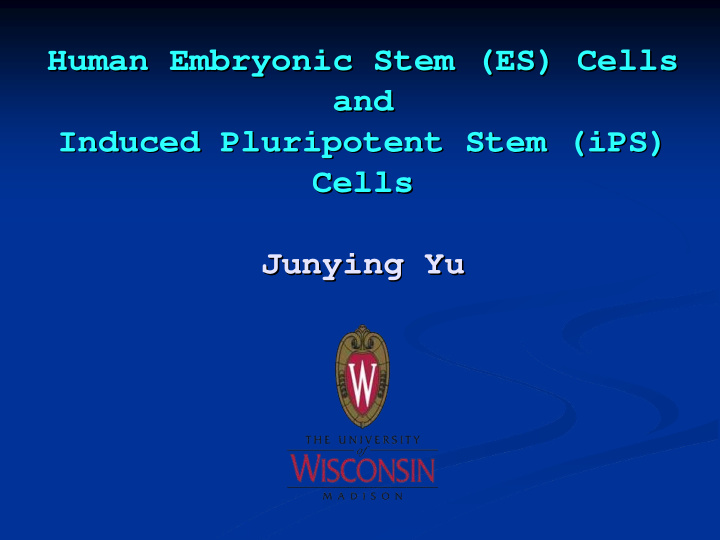



Human Embryonic Stem (ES) Cells Human Embryonic Stem (ES) Cells and and Induced Pluripotent Stem (iPS) Induced Pluripotent Stem (iPS) Cells Cells Junying Yu Yu Junying
What is a Cell? What is a Cell? DNA Nucleus Cytoplasm � Cells are the fundamental, Cells are the fundamental, � structural, and functional units structural, and functional units of living organisms. of living organisms.
Step-wise restriction of differentiation potential during human development
Neurological Diseases Neurological Diseases Parkinson’ ’s Disease s Disease Parkinson � Caused by the death of � Caused by the death of dopaminergic neurons dopaminergic neurons � 1.5 million people affected in � 1.5 million people affected in the U.S. the U.S. $5.6 billion total cost in the � � $5.6 billion total cost in the U.S. U.S. � Fetal tissue transplants have Fetal tissue transplants have � been performed, been performed, but the source of tissue is but the source of tissue is inadequate . inadequate . ALS (Lou Gehrig’ ’s Disease) s Disease) ALS (Lou Gehrig � Caused by death of motor � Caused by death of motor neurons neurons
Heart Disease � Afflicts 1 in 3 people ... � Afflicts 1 in 3 people ... over 70 million Americans over 70 million Americans � The #1 killer in U.S. and � The #1 killer in U.S. and every Wisconsin county ... every Wisconsin county ... over 920,000 people a year over 920,000 people a year (2002) (2002) � Prevalence increasing as � Prevalence increasing as population ages population ages � Costs our nation $393 billion � Costs our nation $393 billion estimated in 2005 estimated in 2005 There is a severe shortage of � � There is a severe shortage of heart donors to treat end heart donors to treat end stage heart failure stage heart failure � The adult heart does not have � The adult heart does not have a stem cell a stem cell
Juvenile Onset Diabetes Juvenile Onset Diabetes � Juvenile onset diabetes is caused by � Juvenile onset diabetes is caused by the death of specific pancreatic the death of specific pancreatic cells (islet cells). cells). cells (islet 1 million people affected in the � � 1 million people affected in the U.S. U.S. More than 15% of U.S. healthcare � � More than 15% of U.S. healthcare dollars. dollars. The transplantation of pancreatic � � The transplantation of pancreatic islet cells has been successful, but cells has been successful, but islet the source of cells is inadequate. the source of cells is inadequate. � It is not yet possible to � It is not yet possible to sustainably culture adult pancreatic sustainably culture adult pancreatic stem cells, and they may not exist. stem cells, and they may not exist.
Embryonic Stem Cells Can Become Embryonic Stem Cells Can Become Any Tissue in the Body Any Tissue in the Body Placenta cell Blastocyst Stem cell Cultured laboratory stem cells Scientific manipulations entice stem cells to become specialized tissues (blood, muscle, neuron, etc.). Muscle cells Blood cells Neuron (brain) cells
Challenges For ES Cell- -Based Based Challenges For ES Cell Transplantation Therapy Transplantation Therapy � � Immune Rejection Immune Rejection � � Making the Cell Type of Interest Making the Cell Type of Interest � � Safety Concerns, Including Cancer Safety Concerns, Including Cancer � � Preventing the Process That Preventing the Process That Killed the Cells Originally Killed the Cells Originally � � Integration in a Physiologically Integration in a Physiologically Useful Form Useful Form
Nuclear Cloning
Nature. 2007 Nov 22 Producing primate embryonic stem cells by somatic cell nuclear transfer. Byrne JA, Pedersen DA, Clepper LL, Nelson M, Sanger WG, Gokhale S, Wolf DP, Mitalipov SM. Oregon National Primate Research Center, Oregon Health & Science University, 505 N.W. 185th Avenue, Beaverton, Oregon 97006, USA.
Human Embryonic Stem Cells are able to reprogram human blood cells Stem Cells. 2006 Jan Human embryonic stem cells reprogram myeloid precursors following cell- cell fusion. Yu J, Vodyanik MA, He P, Slukvin II, Thomson JA. Wisconsin National Primate Research Center, University of Wisconsin, Madison, WI 53706, USA.
Human Embryonic Stem Cells are able to reprogram human blood cells Embryonic stem cells Blood cell x Cell-cell Fusion
What are the factors in human embryonic stem cells involved in reprogramming? - genes whose expression are enriched in human embryonic stem cells.
Identification of genes with enriched expression in human embryonic stem cells � Gene expression analysis Blood ES ~ 150 genes of interest
iPS cells Screening Skin Skin cells
Science. 2007 Nov 20 Induced Pluripotent Stem Cell Lines Derived from Human Somatic Cells. Yu J, Vodyanik MA, Smuga-Otto K, Antosiewicz-Bourget J, Frane JL, Tian S, Nie J, Jonsdottir GA, Ruotti V, Stewart R, Slukvin II, Thomson JA. Genome Center of Wisconsin, Madison, WI 53706-1580, USA.; Wisconsin National Primate Research Center, University of Wisconsin-Madison, Madison, WI 53715-1299, USA.
New and Existing Methods Scientists reprogram cells by injecting retroviruses carrying four genes. Researchers can induce Researchers take skin both cells to become cell samples from any human tissue. patients. Researchers harvest stem cells, destroying the embryo. Scientists take fertilized Egg develops into blastocyst, a 70 -100 cell human egg. mass.
Why Are Human iPS iPS Cells Cells Why Are Human Important? Important? � They allow the development of accurate in vitro disease models � iPS cells with diversity of genetic background can be used for drug screening. � iPS cell technology solves the problem of immune rejection for transplantation therapies.
? ? Human regeneration? Human regeneration?
Urodele Regeneration QuickTime™ and a TIFF (LZW) decompressor are needed to see this picture. QuickTime™ and a TIFF (LZW) decompressor are needed to see this picture.
Acknowledgement Jamie Thomson lab WiCell-Bioinformatics team Kim Smuga-Otto Shulan Tian Other members Jeff Nie Other members Igor Slukvin lab Maxim A. Vodyanik
Recommend
More recommend